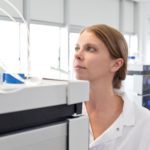Link to Pubmed [PMID] – 17396593
J Sep Sci 2007 Feb;30(3):352-8
Patients with cancer produce specific autoantibodies against protein antigens present in limited amount among a large background of immunoglobulins (Igs), nonrelevant as biomarkers, including natural antibodies. Multiple affinity protein profiling (MAPPing) that combines 2-D immunoaffinity chromatography, enzymatic digestion of the isolated proteins, and identification by MS/MS, may facilitate the identification of these so far unknown patient antibodies. The first immunoaffinity chromatography is crucial, as it is used for selectively removing proteins (autoantigens) recognized by natural antibodies. Application of this depletion step to colon cancer cell proteins is specifically described along with the identification of the natural autoantigens, as well as the coupling of this depletion step with the next steps. By enabling to separate antibody-binding proteins recognized by either natural autoantibodies or patient-specific antibodies this approach may contribute significantly towards the definition of autoantibody signatures.


